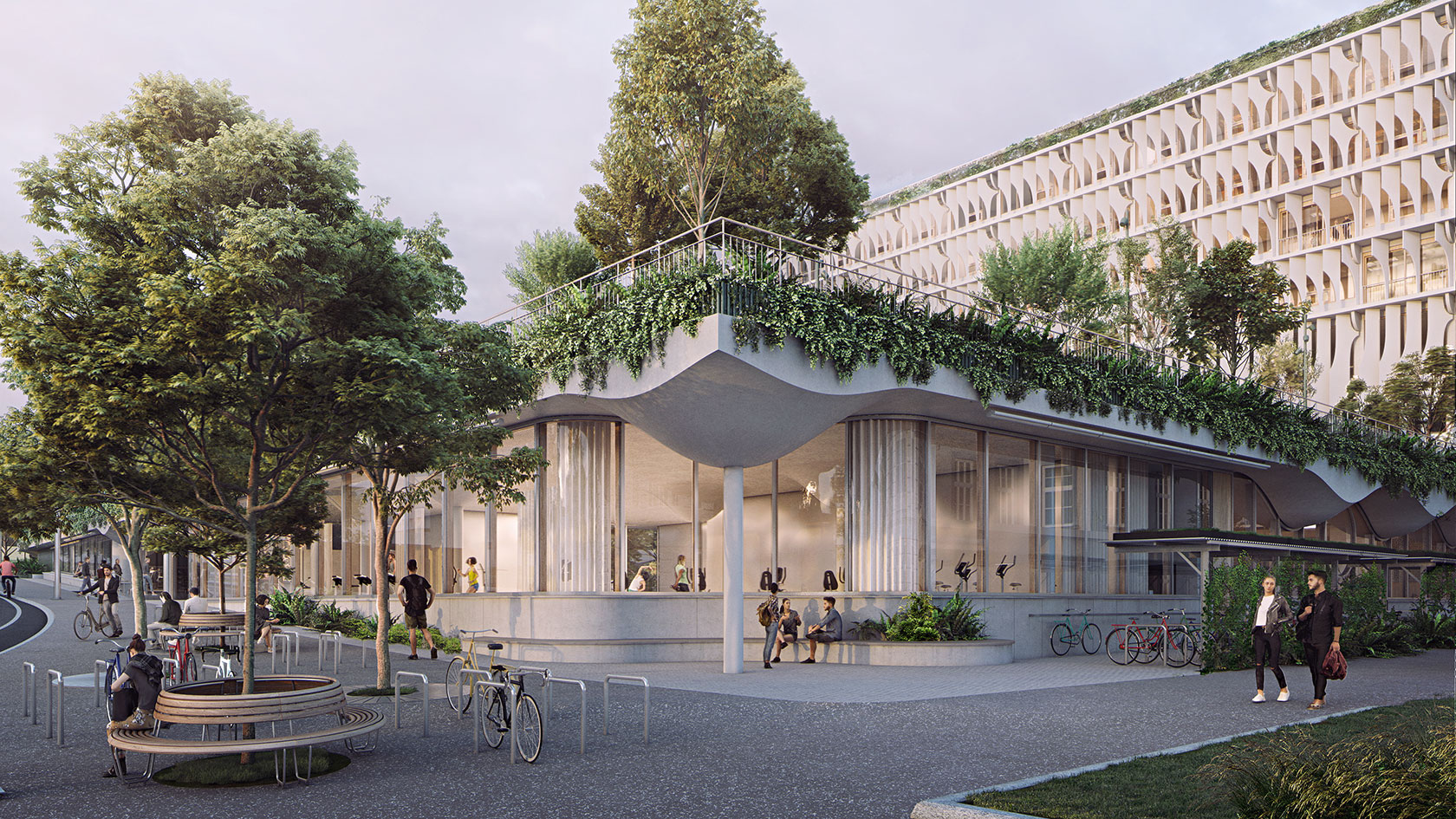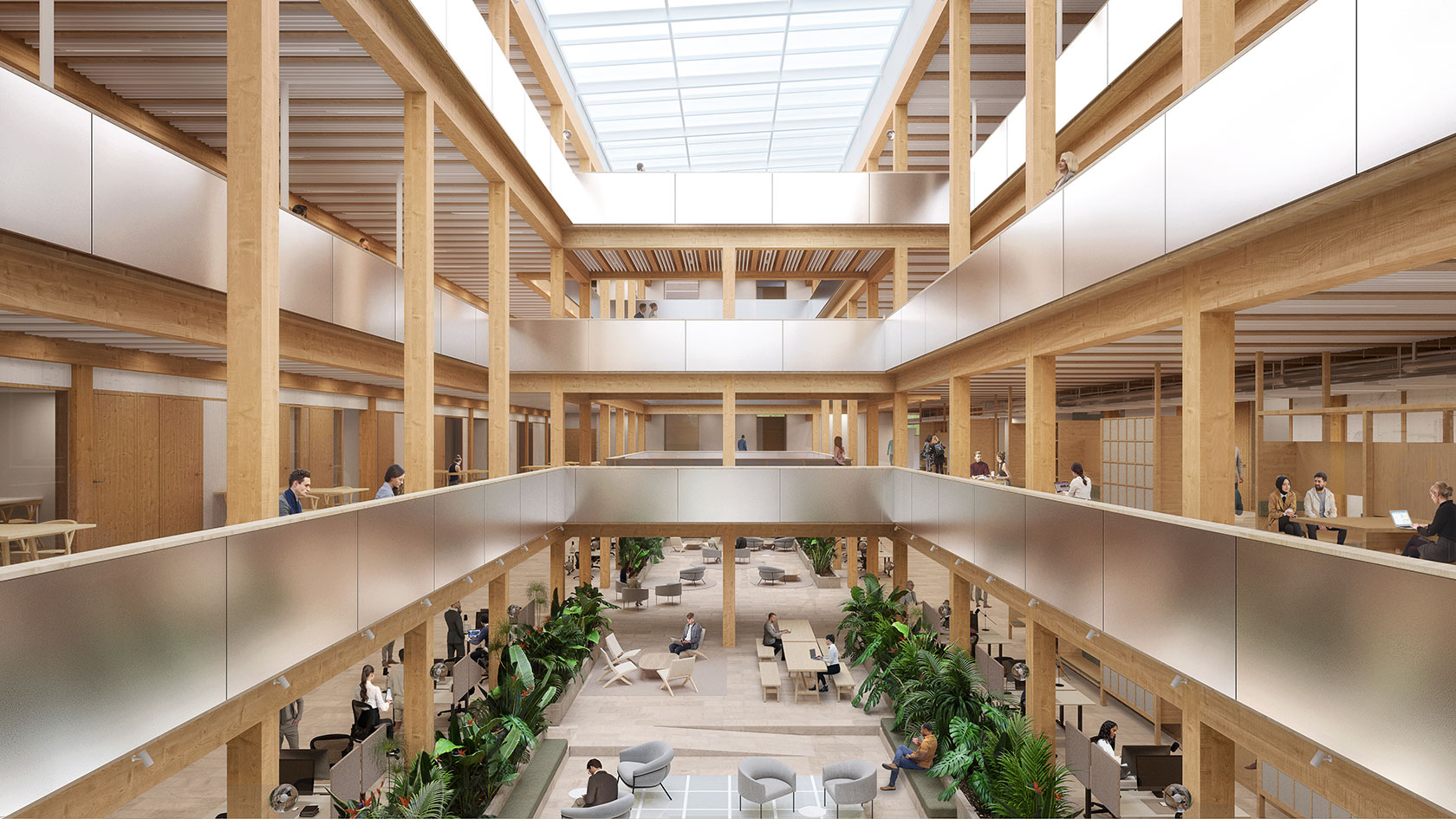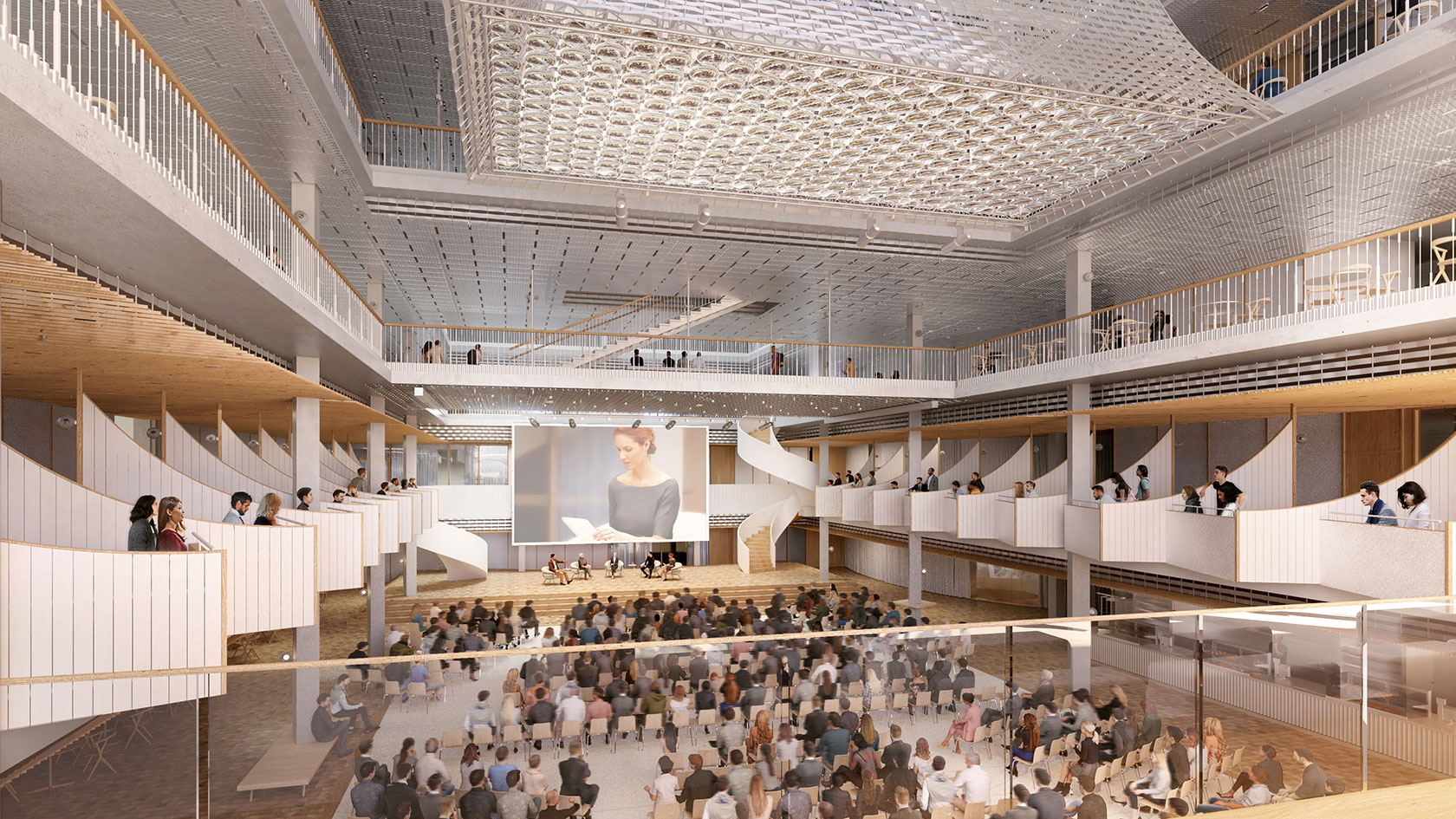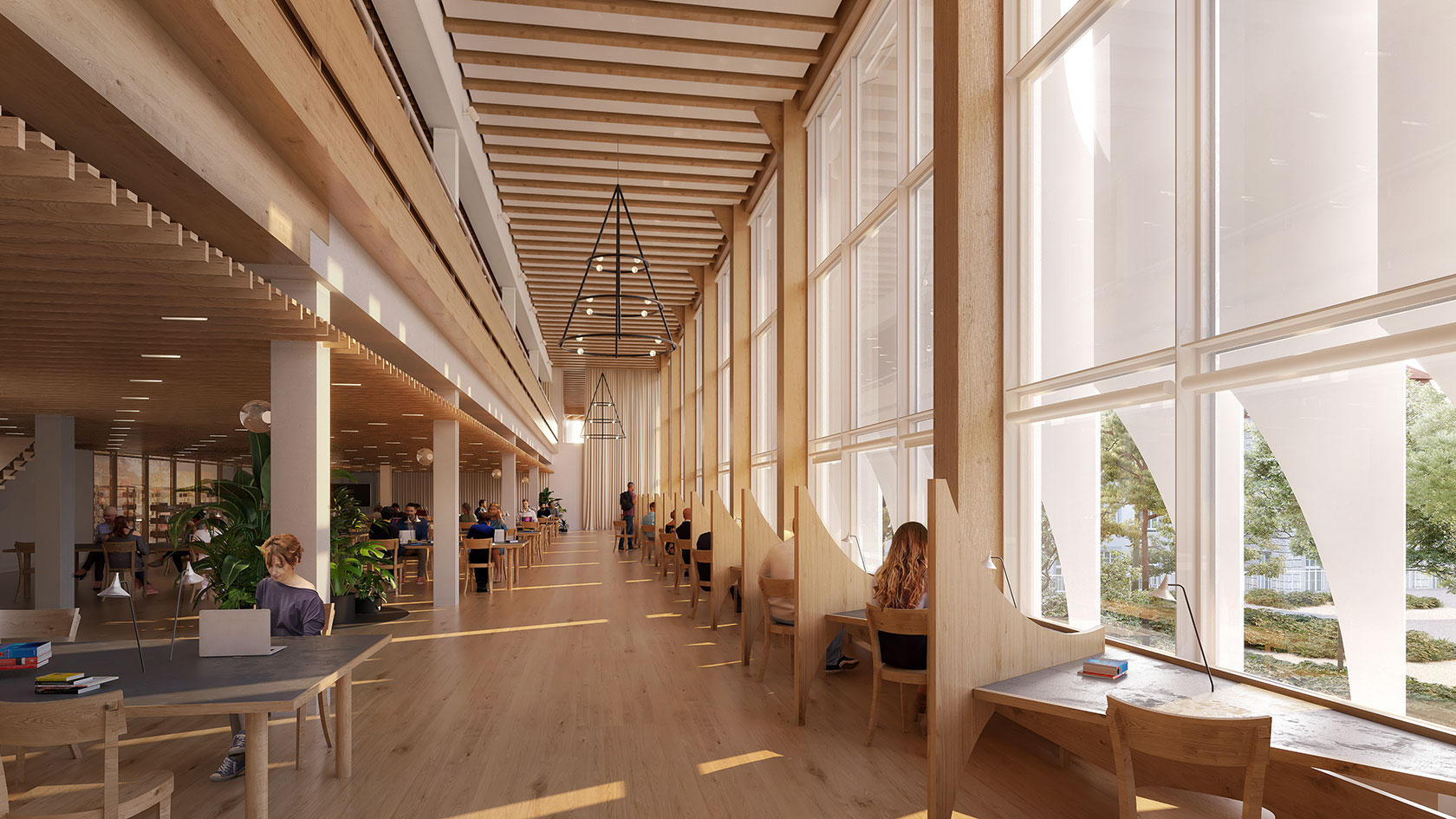The Meeting Place
On the terrace facing Rämistrasse people sit on benches in the shade of the trees, engaged in animated debate. Students emerge from the ASVZ sports facilities downstairs and hurry past to the Study Center at the heart of the building. At the local store below the terrace, neighborhood residents pick up fresh produce for dinner. Two seniors drink coffee outside the café, while students at the next table discuss their term paper.
Driver of community life
That’s the vision presented by architects Herzog & de Meuron for the next phase of expansion at the University of Zurich: the FORUM UZH. Jacques Herzog: “The FORUM UZH will be a driver of community life in this university district. The exterior space is a green public plaza, where residents, students and visitors can mingle and meet. That’s something new in this part of Zurich.”
Located right opposite the main University building between Rämistrasse and Gloriastrasse, the generously planted plaza is the architectural overture to the impressive sweep of the FORUM UZH building itself. With over 37,000 square meters of usable space, it will accommodate almost 6,000 students and staff. Five large lecture halls will seat more than 2,000 people, while some 700 students will find workspaces in the Study Center. And that’s not all. The plans include four gymnasia, sports facilities for the ASVZ, a large cafeteria and other places to eat and drink.
This extra teaching and research space is urgently needed, as student numbers at UZH are expected to reach 30,000 by 2028. Providing enough space for them until the FORUM UZH is ready in 2029 will be a major challenge, says UZH Vice President Real Estate and Facility Management François Chapuis.
Auditorium and Parliament Chamber
The Herzog & de Meuron project is not just about designing a building for the University, but about creating a point of focus that benefits the entire university district. Herzog explains: “The iconic University and ETH buildings opposite have their own, beautifully kept forecourts, but they are dead space. They are not inviting places to spend time in. They weren't intended to be, by the architects or by society.” In contrast, the FORUM UZH will “extend a hand to the public,” says UZH President Michael Schaepman. “We don’t want to present the University as a monolith. The new building is intended to signal accessibility, in other words a conscious blend of students, staff and the public.”
The public plaza in front of the building flows seamlessly into the large, multiple-height forum inside. “It was very important to us to create a real forum,” Jacques Herzog explains. “That’s why the interior is designed to resemble an auditorium, or perhaps even a parliament chamber. It’s a place for people to mix in their day-to-day lives at UZH, but it can also hold major events.”
François Chapuis is delighted. “UZH has never had a stage like this. I hope that, as a university, we will grasp this opportunity and make it a place for the public to enjoy, far beyond its teaching and research function.” The present main building designed by Karl Moser has a striking tower that can be seen for miles, but the FORUM UZH has no such landmark ambitions, says architectural historian Philip Ursprung. “The Moser building really sits atop the city, rising mountain-like above the Zurich skyline. The FORUM UZH is the opposite. It disappears below ground and into its surroundings.” To Ursprung, that reveals much about how society’s perceptions of higher education have changed. During the nation-building age of the 19th and early 20th centuries, countries were still identified by their universities, as they were by their railway stations or opera houses, he explains. Now, however, universities are institutions like many others, viewed with skepticism – if not contempt – by large sections of the population. “Institutes of higher education are today more tolerated than esteemed,” Ursprung believes. In his eyes, the openness radiating from the FORUM UZH is just the right response. “It’s a smart move, because it lowers barriers and demonstrates that town and gown can share the same space.”
The project’s accessibility to the public and the neighborhood regeneration that this urban plaza represents particularly impressed the panel, says François Chapuis. He is no less enthusiastic about the way the building is organized internally, describing it as having an “almost ludicrous mix of uses”. “Herzog & de Meuron have come up with an inspired solution to all our different requirements and their constellations,” he says. The FORUM UZH’s diverse functions are spread across three distinct but interconnected zones. The plinth offers space for teaching, sport and food service. It anchors the multiple stories of an airy structure that incorporates the Study Center and research infrastructure. The two zones are linked by the Forum, a large space five floors high in places. With a capacity of up to 2,000, it also provides an arena for public events.
Understanding the world through architecture
Integrating such a wide range of functions into a single building reflects the way in which research and teaching will intersect in future, Michael Schaepman believes. The FORUM UZH puts everything within reach, fulfilling today’s need to switch quickly between these two aspects of academic life. As Schaepman observes: “We no longer go to the office at eight, leave at five, and spend all our time in the same room.” Instead, the working day consists of a rapid succession of different activities. Research in the office, say, then teaching in a range of formats, then a video call to discuss findings with other researchers. The building offers appropriate working space for it all.
Jacques Herzog also sees how changes in the way we work are shaping the universities of the 21st century: “Life is a continuous learning process and the goal is to acquire new skills. The world is changing faster, and digital technologies are hugely accelerating the impact on working life. Universities remain the focal points of education and academic exchange, but these shifts also impact on what these spaces must deliver.” Architecture, he says, has always been a physical expression of these processes of transformation. “I see architecture as a vehicle for understanding the world and these changes more fully,” says Herzog. This evolution becomes tangible in the FORUM UZH, not just in its physical openness and accessibility, but also in the flexibility and cooperation that it facilitates. “Cooperation is the common thread through many of the skills needed to make it in the professional world today,” notes Michael Schaepman. The University must help students learn to work together in groups. In fact, it must require it. “That is why the lecture halls are designed much more with collaboration and group work in mind.”
One lecture hall calls to mind the English parliament chamber, where students will sit across from each other as if on opposition benches. Another has an optional podium for panel discussions in which the public can take part. “Our idea was for our lecture halls to allow settings that we have not had to date,” François Chapuis explains. Large video walls and the technical set-up for hybrid courses are intended to inspire new teaching formats.
Philip Ursprung sees the FORUM UZH’s functional agility not just as an imperative, but also as one of the building’s architectural qualities: “The lecture halls aren’t simply multiples of the same, but a series of different options. Instead of symmetry, we have diversity.” Yet it is still easy to navigate. “Rather than intimidating and separating, as many institutional structures do, our building connects people.”
Theater boxes for quiet working
Connection is created by the many open-plan spaces that are designed simultaneously to be places to work, meet and discuss. François Chapuis believes that users’ experience of the building will rub off on the University’s working and communications culture. “I’m a fan of the theory that space affects people’s behavior,” he says. The open zones will offer opportunities for informal chats, and could prove to be fertile ground for new ideas. The openness that characterizes the building’s construction means that spaces can be adapted at any time to changing needs. Chapuis explains that the Forum has been planned so that walls can be erected and removed as needed. The building might have a completely different format in 30 years’ time as requirements change: “Changes like that will be possible in future, without having to completely remodel.”
One of the focal points of the FORUM UZH will be the new Study Center and large library. Located in what Chapuis describes as the most beautiful part of the building, this light, double-height space will have more than 700 desks at which students can work individually or in groups. As with the other workplaces, care has been taken to provide a range of settings. Some are unexpected, such as the individual booths like theater boxes arranged overlooking the Forum. They are open to the room behind, but still give a sense of privacy and calm.
The Study Center is one of the highlights of the project for Chapuis. As he says: “This library hub could be such an inspiring place that people just want to hang out here – not to party, but to learn.” President Michael Schaepman also recognizes the importance of the University as a social nexus. He believes that, without social interaction, students are not getting the most out of their education. In his view, dissent requires discussion, between students themselves and with teaching staff, and much spontaneity and depth is lost when those debates are held via Zoom or Teams. Philip Ursprung shares the president’s view that, despite digital communication options, physical buildings will remain hugely important to university life: “Stairwells are often the best breeding ground for ideas, because they are where people stop to talk, and networks are formed sitting on the lawn during breaks. Higher education institutions should continue to have buildings with a beating heart.”
This article first appeared in the UZH Magazin 2/22.



